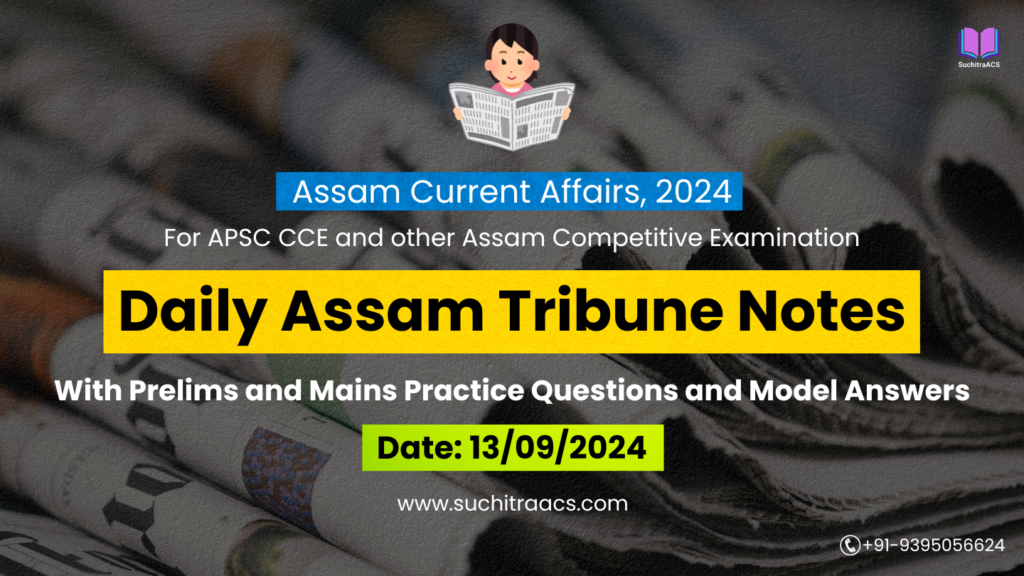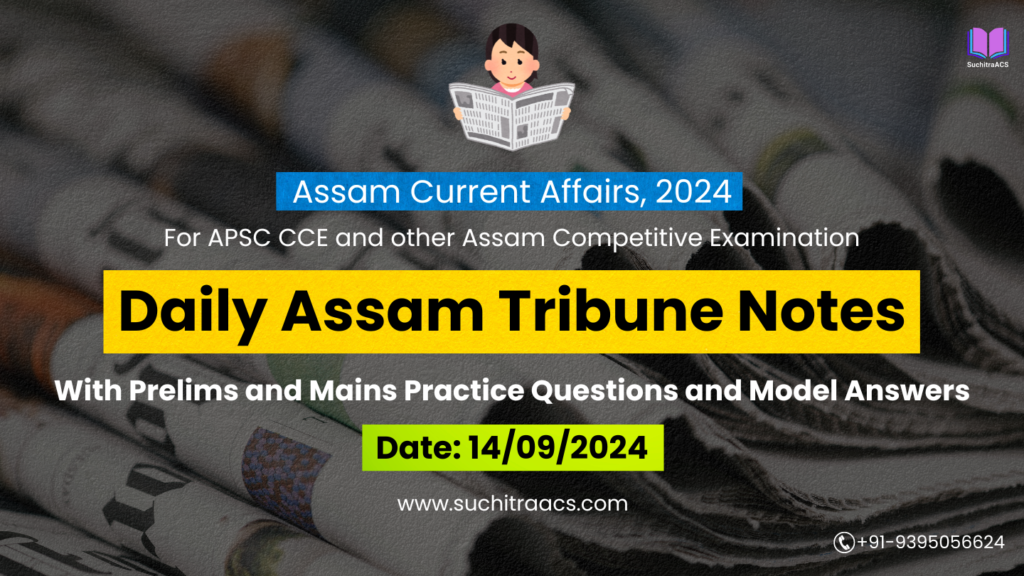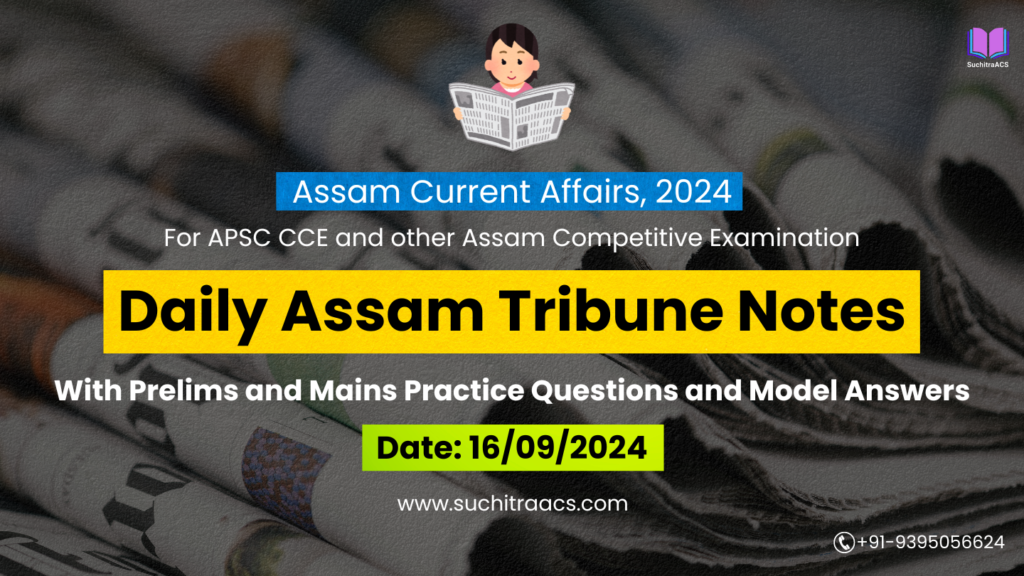APSC Current Affairs: Assam Tribune Notes with MCQs and Answer Writing (02/01/2025)
For APSC CCE and other Assam Competitive examinations aspirants, staying updated with current affairs is vital. This blog covers most important topics from the Assam Tribune today (02-01-2025). These issues are key for both APSC Prelims and Mains preparation, offering insights into the APSC CCE Syllabus.
1. Assam’s Economic Aspirations: Achieving a ₹10 Lakh Crore Economy by 2028
GS Paper 3: Economy
Introduction
Assam’s Chief Minister, Himanta Biswa Sarma, announced a projection for the state to achieve a ₹10 lakh crore economy by 2028. This ambitious goal is rooted in sustainable growth strategies and improved governance aimed at enhancing fiscal health and development benchmarks.
Key Points
- Economic Milestone Projection:
- Assam’s Gross State Domestic Product (GSDP) is expected to reach ₹6.43 lakh crore in 2024-25, with a projected annual growth rate of 12.77%.
- The state aims to surpass Punjab in economic rankings.
- Revenue Growth:
- Significant increases in internal revenue collection, including taxation, excise, transport, and mining.
- A 7% rise in revenue collections over the previous year highlights robust fiscal policies.
- Social Development Initiatives:
- Flagship schemes such as Orunodoi and Mission Basundhara drive inclusive growth and poverty alleviation.
- Assam’s development models are being emulated by other states, including Karnataka and Maharashtra.
- Crime Reduction and Governance:
- Marked decline in crime rates, with registered cases dropping from over 1.3 lakh in 2021 to 49,966 in 2024.
- Improved conviction rates and decreased crime per capita underscore effective governance.
Prelims Pointers
- Orunodoi Scheme: A direct benefit transfer scheme targeting poverty alleviation.
- Mission Basundhara: Focused on land records modernization and dispute resolution.
- Charaideo Moidams: Recently recognized as a UNESCO World Heritage Site.
Mains Pointers
Importance of Economic Growth:
- Fiscal Strength:
- Enhanced GSDP rankings improve Assam’s financial credibility.
- Attracts investments in sectors like infrastructure, technology, and education.
- Social Impact:
- Poverty alleviation through inclusive flagship schemes.
- Reduction in urban and rural economic disparities.
- Employment Generation:
- Investments in hydroelectric projects and industrial growth create jobs.
- Empowerment through skill development programs.
Challenges:
- Infrastructure Deficit:
- Inadequate transport and industrial infrastructure may hinder growth.
- Disaster Management:
- Vulnerability to floods and natural calamities affecting agriculture and livelihoods.
- Revenue Optimization:
- Over-dependence on central assistance and limited diversification in revenue sources.
Government Initiatives:
- Hydroelectric Projects: Acquisition of hydroelectric projects in Bhutan and Arunachal Pradesh to stabilize power tariffs and boost energy security.
- Flagship Programs: Schemes like Orunodoi promote grassroots development.
- Digital Governance: Enhanced efficiency through digitalization of services and land records.
Way Forward:
- Strengthen Infrastructure: Focus on transportation, industrial corridors, and smart city projects.
- Diversify Revenue Sources: Leverage tourism, IT, and startups for economic diversification.
- Disaster Resilience: Invest in flood management systems and climate-resilient agriculture.
- Skill Development: Expand vocational training programs aligned with industry needs.
Conclusion
Assam’s vision to become a ₹10 lakh crore economy by 2028 is ambitious but achievable through strategic planning and inclusive policies. A balanced focus on infrastructure, governance, and social development will enable the state to set a benchmark for economic growth in the Northeast, fostering prosperity for its citizens.
2. Justice Sharma Panel on Clause 6 of the Assam Accord
GS Paper 2: Polity and Governance
Introduction
The Assam government, under Chief Minister Himanta Biswa Sarma, has announced plans to implement most of the recommendations of the Justice Biplab Kumar Sharma Commission related to Clause 6 of the Assam Accord. This clause seeks to safeguard the cultural, social, and linguistic identity of Assamese people.
Key Points
- Clause 6 of the Assam Accord:
- Envisions constitutional, legislative, and administrative safeguards for the Assamese people.
- Aimed at preserving Assamese culture, heritage, and linguistic identity.
- Justice Sharma Commission Recommendations:
- Provisions for safeguarding land rights and cultural preservation.
- Special provisions for employment and education for Assamese people.
- Current Government Actions:
- The state aims to implement all actionable recommendations within its purview by April 2025.
- Efforts to address debatable issues, including cadastral surveys in char (riverine) areas, through stakeholder consultations.
- Engagement with Tribal Groups:
- Ongoing dialogues with tribal communities and the All Assam Students’ Union (AASU) to ensure inclusive policy implementation.
Prelims Pointers
- Assam Accord (1985): Signed between the Government of India and AASU to end the Assam agitation, ensuring protection of indigenous rights.
- Cadastral Survey: A comprehensive survey of land parcels for ownership and land-use mapping.
- Char Areas: Riverine regions of Assam, prone to erosion and home to vulnerable communities.
Mains Pointers
Importance of Implementing Clause 6:
- Cultural Preservation:
- Ensures the survival of Assamese identity amidst demographic changes.
- Social Stability:
- Resolves long-standing grievances of indigenous communities.
- Political Significance:
- Addresses regional concerns, strengthening federal cooperation.
Challenges in Implementation:
- Complexity of Land Rights:
- Resolving disputes over land ownership in char areas.
- Inclusivity:
- Balancing the interests of various indigenous and tribal groups.
- Political Consensus:
- Ensuring alignment among state, central government, and stakeholders like AASU.
Government Initiatives:
- Stakeholder Consultations: Involving AASU and tribal groups in policy discussions.
- Legislative Efforts: Drafting new policies based on commission recommendations.
- Development Programs: Promoting socio-economic growth in vulnerable regions.
Way Forward:
- Clear Policy Framework: Establish a roadmap with specific timelines for implementation.
- Capacity Building: Strengthen institutions for efficient execution of land and cultural safeguards.
- Public Awareness: Educate citizens on the implications and benefits of Clause 6 provisions.
- Periodic Review: Monitor and adjust policies to address emerging challenges.
Conclusion
The implementation of Clause 6 of the Assam Accord is a pivotal step toward honoring the promises made in 1985. By safeguarding Assamese identity and addressing stakeholders’ concerns, the government can foster harmony and development in the region. Effective execution will not only preserve Assam’s rich heritage but also set a precedent for resolving identity-based challenges across India.
3. India’s Defence Reforms and Theaterisation Plan
GS Paper 3: Security
Introduction
India has declared 2025 as the year of defence reforms, emphasizing the establishment of integrated theatre commands and streamlining defence procurement. These reforms aim to modernize the armed forces, enhance tri-services synergy, and optimize resource utilization for a robust defence posture.
Key Points
- Integrated Theatre Commands:
- Proposed integration of Army, Navy, and Air Force units under unified command structures for specified geographic regions.
- Focus on efficient resource allocation and operational readiness.
- Modernization Goals:
- Transformation into a technologically advanced combat-ready force.
- Emphasis on emerging technologies like artificial intelligence (AI), hypersonic systems, and robotics.
- Defence Procurement Reforms:
- Simplification of acquisition processes to ensure timely availability of critical systems.
- Promotion of indigenous defence production under initiatives like “Make in India.”
- New Domains of Focus:
- Cybersecurity and space as priority areas for defence preparedness.
Prelims Pointers
- Integrated Theatre Commands: Unified command structures integrating land, air, and naval assets.
- Project 75: Indigenous development of Scorpene-class submarines, including the newly inducted Vagsheer.
- Indigenization Initiatives: Projects like stealth frigates (Nilgiri class) and advanced destroyers (Surat class).
Mains Pointers
Importance of Defence Reforms:
- Operational Synergy:
- Unified commands eliminate inter-service duplication and enhance joint operations.
- Strategic allocation of resources improves efficiency and responsiveness.
- Indigenous Capabilities:
- Boosts self-reliance in defence production and reduces dependence on imports.
- Encourages innovation in critical technologies like AI, machine learning, and hypersonic weapons.
- Geopolitical Significance:
- Strengthens India’s position as a global military power.
- Enhances preparedness against regional threats from adversaries like China and Pakistan.
Challenges:
- Inter-Service Rivalries:
- Resistance to structural changes in command hierarchies.
- Technology Integration:
- Need for infrastructure to support AI and cyber operations.
- Procurement Delays:
- Bureaucratic bottlenecks hinder timely acquisition and deployment.
Government Initiatives:
- Defence Procurement Procedure (DPP): Streamlining acquisition processes to reduce delays.
- Defence Industrial Corridors: Boosting domestic production capabilities in Tamil Nadu and Uttar Pradesh.
- Collaboration with Global Partners: Partnerships with countries like the US, Russia, and France for advanced technologies.
Way Forward:
- Accelerated Implementation: Expedite establishment of theatre commands and procurement reforms.
- Capacity Building: Develop infrastructure for emerging domains like cyber and space defence.
- Public-Private Partnerships: Engage private sector and startups to foster innovation.
- Periodic Assessment: Evaluate the effectiveness of reforms and make necessary adjustments.
Conclusion
India’s defence reforms, including the ambitious theaterisation plan, mark a significant shift towards modernization and self-reliance. These initiatives will not only enhance operational capabilities but also solidify India’s position as a formidable global power. By overcoming challenges and fostering a unified defence strategy, the nation can ensure its security and sovereignty in an increasingly complex geopolitical landscape.
4. Assam’s Progress in Renewable Energy: Hydroelectric Projects Acquisition
GS Paper 3: Energy and Environment
Introduction
Chief Minister Himanta Biswa Sarma announced that Assam is set to acquire two hydroelectric projects—one in Bhutan and another in Arunachal Pradesh. This development reflects the state’s commitment to renewable energy, aiming to stabilize power tariffs and enhance energy security.
Key Points
- Hydroelectric Projects Acquisition:
- Assam plans to co-own hydroelectric projects in Bhutan and Arunachal Pradesh.
- Expected to provide long-term, sustainable energy at reduced costs.
- Impact on Power Tariffs:
- Profits generated by Assam Power Distribution Company Limited (APDCL) will reduce tariffs by ₹0.50 to ₹1.50 per unit in 2025.
- Focus on Renewable Energy:
- Hydropower as a sustainable and clean energy source.
- Reduces dependence on fossil fuels and mitigates greenhouse gas emissions.
- Regional Energy Collaboration:
- Strengthens ties with Bhutan and Arunachal Pradesh through energy-sharing agreements.
Prelims Pointers
- APDCL: Assam Power Distribution Company Limited, managing electricity distribution in the state.
- Hydropower Benefits: Clean, renewable energy source contributing to energy security.
- Bhutan-India Hydropower Collaboration: Bhutan exports electricity to India under existing hydropower agreements like Tala and Punatsangchhu.
Mains Pointers
Importance of Hydropower for Assam:
- Energy Security:
- Reliable and cost-effective electricity supply for industrial and domestic needs.
- Stabilizes power distribution in flood-prone and rural areas.
- Economic Growth:
- Attracts investment in industrial sectors with reduced energy costs.
- Promotes local employment during project construction and maintenance phases.
- Environmental Benefits:
- Clean energy aligns with India’s climate commitments under the Paris Agreement.
- Reduces carbon footprint and dependency on thermal power.
Challenges in Hydropower Development:
- Environmental Concerns:
- Potential ecological disruptions in project areas, including displacement of communities.
- Interstate Coordination:
- Disputes over water-sharing and resource management with neighboring states.
- High Initial Costs:
- Capital-intensive nature of hydroelectric projects requires long-term financial planning.
Government Initiatives:
- Hydropower Policies: Incentives for renewable energy projects under the Ministry of Power.
- North-East Power System Improvement Project: Enhances power distribution infrastructure across Northeastern states.
- Bhutan-India Hydropower Agreements: Strengthens energy collaboration for mutual benefits.
Way Forward:
- Integrated Energy Strategy: Develop policies for equitable water-sharing and regional cooperation.
- Community Engagement: Ensure local participation to address displacement and ecological concerns.
- Focus on Technological Advancements: Use modern methods to minimize environmental impact.
- Financial Sustainability: Leverage public-private partnerships for efficient funding and execution.
Conclusion
Assam’s acquisition of hydroelectric projects is a transformative step toward renewable energy leadership. By addressing challenges and fostering regional cooperation, the state can achieve energy security while contributing to environmental sustainability. This initiative reinforces Assam’s role in India’s renewable energy landscape and its vision for a green future.
APSC Prelims Practice Questions
Topic 1: Assam’s Economic Aspirations
- What is the projected nominal GSDP of Assam for 2024-25 at current prices?
- (a) ₹5.7 lakh crore
- (b) ₹6.43 lakh crore
- (c) ₹7.12 lakh crore
- (d) ₹10 lakh crore
Answer: (b)
- Which flagship scheme of Assam has been recognized as a model for poverty alleviation by other states?
- (a) Mission Basundhara
- (b) Orunodoi
- (c) Ujjwala Yojana
- (d) Jal Jeevan Mission
Answer: (b)
- Which of the following highlights Assam’s internal revenue growth in 2024?
- (a) 5%
- (b) 7%
- (c) 9%
- (d) 12%
Answer: (b)
- Which achievement of Assam in 2024 was recognized globally?
- (a) Charaideo Moidams as a UNESCO World Heritage Site
- (b) Introduction of e-governance in all districts
- (c) Development of hydropower plants in Bhutan
- (d) Highest tea exports in India
Answer: (a)
Topic 2: Justice Sharma Panel on Clause 6
- What is the main objective of Clause 6 of the Assam Accord?
- (a) Addressing flood management in Assam
- (b) Providing constitutional safeguards to the Assamese people
- (c) Facilitating industrial development in Assam
- (d) Enhancing border security with neighboring states
Answer: (b)
- What major issue is associated with the implementation of Clause 6 recommendations?
- (a) Conducting cadastral surveys in char areas
- (b) Expanding Assam’s industrial infrastructure
- (c) Finalizing hydroelectric projects in Arunachal Pradesh
- (d) Increasing internal revenue growth
Answer: (a)
- Which key stakeholder group is consulted for implementing Clause 6 recommendations?
- (a) North Eastern Council
- (b) All Assam Students’ Union (AASU)
- (c) Indian National Congress
- (d) United Nations Development Programme
Answer: (b)
Topic 3: Defence Reforms and Theaterisation
- What is the primary goal of India’s defence reforms announced for 2025?
- (a) Expansion of the Army’s size
- (b) Establishment of integrated theatre commands
- (c) Reduction in defence imports
- (d) Creation of additional naval bases
Answer: (b)
- Which of the following is NOT a focus area of India’s defence reforms for 2025?
- (a) Artificial intelligence and robotics
- (b) Cybersecurity and space operations
- (c) Indigenous fighter aircraft development
- (d) Renewable energy technology in defence units
Answer: (d)
- Under the proposed theaterisation model, what is the key benefit of integrated theatre commands?
- (a) Separation of Army, Navy, and Air Force operations
- (b) Unified and coordinated use of resources across services
- (c) Increased deployment of foreign defence advisors
- (d) Focus solely on maritime security challenges
Answer: (b)
Topic 4: Hydroelectric Projects in Assam
- Which two regions are involved in Assam’s planned hydroelectric project acquisitions?
- (a) Bhutan and Arunachal Pradesh
- (b) Meghalaya and Tripura
- (c) Nepal and Arunachal Pradesh
- (d) Sikkim and Bhutan
Answer: (a)
- What is the estimated reduction in power tariffs due to Assam’s hydroelectric project acquisitions?
- (a) ₹0.50 to ₹1.50 per unit
- (b) ₹2.00 to ₹3.00 per unit
- (c) ₹0.25 to ₹0.75 per unit
- (d) ₹1.00 to ₹2.00 per unit
Answer: (a)
- Which organization manages electricity distribution in Assam?
- (a) Assam State Power Corporation
- (b) Assam Electricity Board
- (c) Assam Power Distribution Company Limited (APDCL)
- (d) North-East Energy Corporation
Answer: (c)
- What type of energy source is targeted through Assam’s hydroelectric projects?
(d) Wind energy
Answer: (c)
(a) Fossil fuels
(b) Solar energy
(c) Hydropower
APSC Mains Practice Question
Q. Discuss the significance of Clause 6 of the Assam Accord in preserving the socio-cultural identity of Assamese people. Highlight the challenges in its implementation and suggest measures to ensure its effective execution.
Model Answer
Introduction
Clause 6 of the Assam Accord, signed in 1985, seeks to provide constitutional, legislative, and administrative safeguards to protect the cultural, social, and linguistic identity of the Assamese people. It remains a cornerstone in addressing the concerns of indigenous communities amidst changing demographics and socio-political challenges.
Significance of Clause 6
- Cultural Preservation:
- Ensures the survival of Assamese traditions, language, and heritage amidst external influences.
- Protects the unique identity of indigenous communities in a rapidly globalizing world.
- Political Relevance:
- Reflects the government’s commitment to fulfilling promises made during the Assam agitation.
- Strengthens regional governance and representation for indigenous groups.
- Social Cohesion:
- Addresses long-standing grievances of Assamese people, fostering harmony.
- Promotes inclusive development by empowering local communities.
- Economic Development:
- Special provisions for land rights and employment for indigenous people reduce economic disparities.
- Encourages investments in sectors like tourism and handicrafts that leverage Assam’s cultural richness.
Challenges in Implementation
- Land Ownership Disputes:
- Cadastral surveys in char (riverine) areas remain contentious due to overlapping claims and displacement.
- Balancing Interests:
- Ensuring inclusivity among various ethnic groups without alienating smaller tribes.
- Lack of Consensus:
- Divergent views among stakeholders, including the All Assam Students’ Union (AASU) and tribal communities.
- Demographic Shifts:
- Influx of migrants complicates the identification of beneficiaries for Clause 6 safeguards.
Measures for Effective Implementation
- Clear Policy Framework:
- Define eligibility criteria and specific benefits for Clause 6 implementation through legislation.
- Stakeholder Engagement:
- Conduct consultations with AASU, tribal groups, and local communities to build consensus.
- Strengthen Land Management:
- Expedite cadastral surveys using modern technology to resolve land disputes efficiently.
- Awareness Campaigns:
- Educate citizens on the importance of Clause 6 to foster public support and reduce resistance.
- Periodic Review Mechanism:
- Establish a monitoring committee to track progress and address emerging challenges.
Conclusion
Clause 6 of the Assam Accord is a pivotal instrument for preserving the socio-cultural fabric of Assam. While challenges persist in its implementation, a collaborative and transparent approach can ensure its success. Effective execution will not only safeguard Assamese identity but also set a precedent for resolving similar issues in other regions of India.
✨ APSC Prelims Crash Course, 2025
at most affordable rate in Assam!

🔔 Join Our WhatsApp Study Group!
For exclusive access to premium quality content, including study materials, current affairs, MCQs, and model answers for APSC CCE and other Assam competitive exams.
Click here to join: SuchitraACS Study WhatsApp Group
📚 Want to know more about SuchitraACS’s most affordable courses?
Click here to know more: SuchitraACS Courses for APSC CCE and Assam Competitive Examinations




